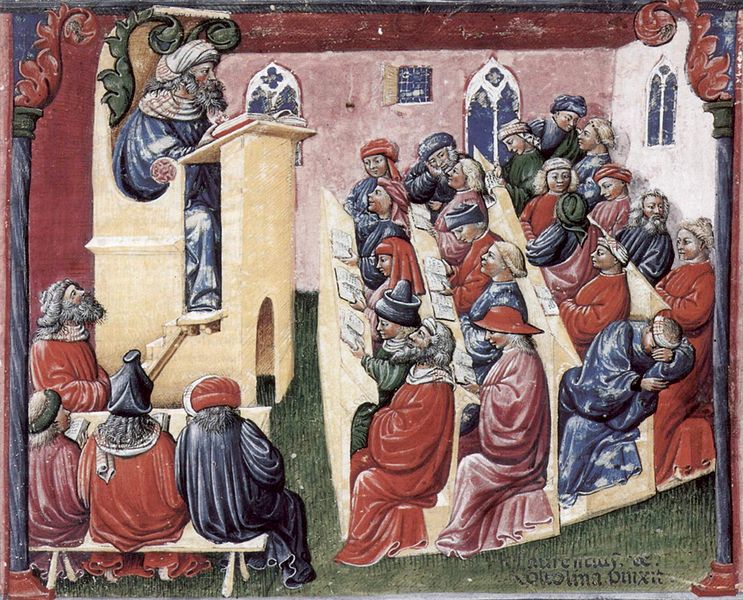Students and Masters
Most of the students at medieval universities departed after two years or less without acquiring a bachelor’s degree. The percentage of students awarded that degree was thus relatively small. The longer the time required for the successful completion of a degree, the smaller was the percentage of students who received it. Whereas the bachelor’s degree required three or four years, the master of arts degree demanded one or two years beyond that, for a total of five or six years of schooling. Occasionally, the time needed extended beyond, to seven or even eight years. The master of arts degree was a prerequisite for entry into one of the higher faculties of law, medicine, and theology, each of which demanded a number of additional years of study. Thus the number of students who successfully completed degrees in the higher faculties represented a small percentage of the total student community, perhaps smaller than the percentage of those who complete doctorates in modem universities. A student’s attendance at a university, even for a short period of time, even without acquisition of a degree, was viewed favorably by society and was considered helpful in shaping the student’s career.
During the Middle Ages, no hierarchy of educational institutions existed that was comparable to the sharp divisions between modem elementary schools, high schools, and colleges or universities. Previous attendance at a “lower-level“ school was, therefore, not required for admission. Indeed, even the ability to read and write Latin may not have been essential. In the virtual absence of preconditions or prerequisites, entering a medieval university was relatively simple. There were, however, two indispensable requirements for admission.
The first was official matriculation, which was the responsibility of the university rector. To achieve matriculation, an entering student, who was usually fourteen or fifteen years of age, had to pay a fee and take an oath. The oath varied from university to university but usually involved the student’s affirmation of loyalty to the rector and a promise to promote the welfare and integrity of the university. The student also swore that he would take no vengeance for any wrongs that might befall him. In return, the rector admitted the student into the university community and was thereafter expected to protect him when necessary. Despite its significance, the oath-taking ceremony itself was largely a formal exercise.
This was not true for the second indispensable requirement, however, which compelled each entering student to attach himself to a master. Students associated with the same master formed a natural group. Their academic fates were subject to his jurisdiction, and he was, accordingly, expected to introduce the students to the university community and to university life. He also prepared his students for examinations by seeing that they met the various test requirements in the proper sequence. Presumably, the master also laid out a course of study for his students whereby they attended his lectures over a period of three or four years and perhaps also took suggested classes offered by other masters. The selection of a master by a student was probably made on the basis of personal criteria, which might involve some considerations as geography, family connections, and friendships. It seems likely that master-student clusters allowed for more personalized relationships within the more formal and perhaps forbidding institutional structure of the university as a whole. […]
University instruction centered upon the lecture (lectio) and the disputation (disputatio). Lectures were of two basic kinds, ordinary and extraordinary. Ordinary lectures lay at the heart of the teaching program and were always given in the morning by designated regent masters, that is, active teaching masters. As a sign of their importance, no other lectures or activities were permitted during the delivery of ordinary lectures. By contrast, extraordinary lectures were usually given in the afternoon, after ordinary lectures, or on a day when no ordinary lecture was scheduled. Extraordinary lectures were more flexible and informal than their ordinary counterparts and could be given by students as well as by masters. A third, less important, type of lecture, also offered in the afternoon, was called cursory and usually involved a summary or review of problems derived from a standard text.
The purpose of ordinary lectures was to present the required texts that comprised the official curriculum. Modern scholars have said little about what actually occurred in a typical medieval university classroom, probably because teachers and students left few descriptions of their classroom experiences. It is likely, however, that classroom lectures were a passive experience for the students, who simply listened and perhaps took a few notes. Students who had a copy of the text being discussed — and few did — might even follow along. […]
Scholastic disputations, in which the students were prominent participants, were a vital aspect of university education. Whereas students may have been passive auditors in the medieval lecture halls, disputations offered them the opportunity to apply what they had absorbed. By analogy with lectures, disputations were divided into ordinary and extraordinary. The ordinary disputation (disputatio ordinaria) had the same exalted status as the ordinary lecture. Masters held these disputations on a regular basis, usually once a week, and required their students to attend. Other masters might also attend a colleague’s ordinary disputation. The presiding master, however, posed the question, one that he might have wished to examine more carefully than his ordinary lectures permitted. The other masters and students participated, some supporting the affirmative side, others the negative side. It was the presiding master, however, who “determined” the question — that is, who synthesized the various arguments into a definitive answer to the problem.
— Edward Grant, Foundations of Modern Science in the Middle Ages (New York: Cambridge University Press, 1996), pp. 30-40.

.jpg)
